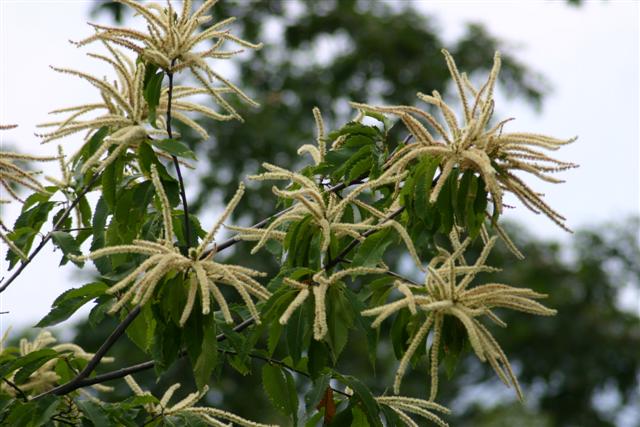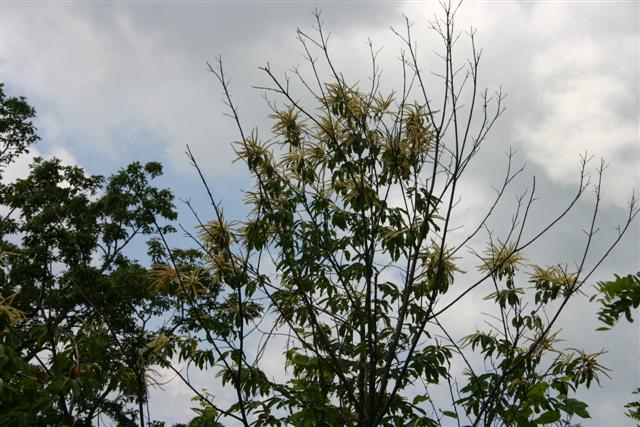Ask An Arborist: September 2, 2010
Sponsored By Bartlett Tree Experts
| The American Chestnut |
| Castanea dentata |

|

|
| Male Flowers (Catkins) |
Dieback from Blight |
The story of the American chestnut tree is one of the saddest tales in the natural history of the United States. Once the most
predominant and largest tree east of the Mississippi, it has been nearly wiped out by Asian chestnut blight that made its way into
this country in the early 20th century. Prior to the blight, the American chestnut represented 25% of the forest
trees in its native range. By the 1940s, itís estimated that nearly 4 billion chestnut trees had died from the blight.
Only old
photographs
exist of fully mature healthy trees, some of which appeared to have rivaled the redwoods of the west.
The nuts produced by the American chestnut were larger and considered to be far superior in taste and quality than Chinese
chestnuts, usually the only commercially available chestnut now found in stores. Before the destruction of the trees by disease,
many of the poorest communities in Appalachia depended upon the gathering and sale of the chestnuts for their livelihood.
The nuts were also a staple food for humans and wildlife alike. The trees provided shade and cover for many species of animals
and the wood was harvested for buildings and furniture. Then came the blightÖ
Chestnut blight (Cryphonectria parasitica) is a fungal disease which originated in Asia. Native chestnuts, including the
Chinquapin (Castanea pumila) are highly susceptible to this foreign invading pathogen. Asian species of chestnuts evolved
alongside the blight and show varying degrees of resistance and are rarely killed. The disease causes cankers and eventually the
entire part of the tree above the root collar dies. The roots are usually unaffected and many trees begin the process of growing
back as stump sprouts which can still be seen quite commonly along the Blue Ridge Parkway. Often the stump sprouts are able to
attain enough maturity to flower and produce nuts before they are again killed back to the ground by the disease. This has given
the species a glimmer of hope.
In 1983, the American Chestnut Foundation was founded by a group of plant scientists. Their mission is to introduce the genes
that confer blight resistance from Chinese chestnuts into American chestnuts. Eventually, they hope to achieve hybrid
American/Chinese chestnuts that will retain 94% or more of the American chestnut genes while carrying the Chinese genes for
blight resistance. This has involved a complicated and decades-long cross and back-breeding program that is still ongoing today.
Once they achieve their goal of as-close-as-possible genetically pure blight resistance American chestnut hybrids (and I think
they will), they will reintroduce them into the forests of the eastern U.S. and eventually make them available to the trade for
sale.
Many who have read my writings know that Iím usually opposed to cross-breeding native species with exotic species as this can
cause the loss of precious native plant genetic material. However, in this instance we risk extinction of the tree unless
something is done. Also, the diligence and care being taken in the breeding program is striving to preserve as much genetic
diversity as possible from our American chestnuts.
The American Chestnut Foundation welcomes information from the public on the
location of blooming-age American chestnut stump sprouts or trees that can be used to increase diversity in their breeding program. You can even purchase pure American chestnut seeds from them for planting. Although your trees will eventually succumb to the disease, you may be able to contribute vital genetic material to their program. I was fortunate enough to spot three American chestnuts in 2008 along the Blue Ridge Parkway in North Carolina. They were right next to the road, easily accessible, and in full bloom (see images above). They were also afflicted with the blight. As soon as I had cell reception, I was on the phone to report their location.
For more information, visit this site:
American Chestnut Foundation
Please email me if you have any questions or topics you would like to submit
for later articles.
If you are concerned about the trees in your landscape, you can contact
Bartlett Tree Experts.
Unless otherwise noted, Images & Drawings Copyrighted © 2010 by Theresa Schrum - All rights reserved



